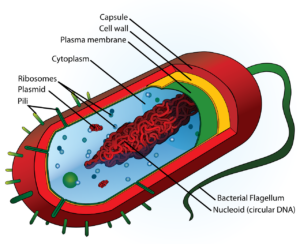Bacteria comprise a single cell and the single cell is considered a whole organism.
Bacteria are single-celled prokaryotic organisms. They do not possess any internal membranous organelles and their morphology or cellular organization is so simple, this differentiates them from being a eukaryote as they have complex structures. Bacteria have no nucleus and other complex organelles.
As the bacteria’s cellular organisation is very simple, this differentiates it from being a eukaryote as eukaryotic organisms have complex structures. Bacteria being a prokaryote has no nucleus and other complex organelles.
Are Bacteria Prokaryotic Or Eukaryotic?
Bacteria are prokaryotic organisms
We just saw the answer for, Are Bacteria Prokaryotic Or Eukaryotic? now, how are bacteria considered prokaryotes? what are the structures present inside the cell? All details regarding it will be discussed in this article.

Image credits- Pixabay
Why are bacteria called prokaryotes?
We already know that the cell must be a prokaryote or eukaryote. So the chief difference between a prokaryote and a eukaryote is regarding the presence of a nucleus.
Bacteria do not have a nucleus to be more precise, they do not have a true nucleus so this concluded that bacteria is a prokaryotic organism.
Prokaryotic bacteria characteristics
- Bacteria are single-celled organisms that are they are Unicellular structures.
- They are very small that they can not be viewed by the naked eye. The microscope is used to visualize bacteria.
- Bacteria do not have any membrane-covered organelles like Golgi bodies, mitochondria, chloroplast.
- Bacteria do not have a well-defined nucleus.
- Bacteria have circular DNA that is present freely in the cytoplasm of the cell. Circular DNA is adhered to the cell membrane/plasma membrane and is known as the nucleoid.
- Bacterial cell size ranges from 0.1 to 5.0 micrometre.
- The bacterial cell is made up of complex polysaccharides.
Are all bacteria prokaryotes?
Yes, all bacteria are prokaryotes as their cellular organization is so simple and lacks a true nucleus.
Internal structures present in the bacterial cell
Though bacteria is a single-celled organism or unicellular organism, the single cell is able to perform and survive as a whole organism with the aid of certain internal structures
There are a few components present inside the bacterial cells. It is not mandatory that all bacteria must possess these components. Depending upon their type and survival, they may or may not have certain components.
The components present inside the bacterial cells are:
- Cell wall:The main use of a cell wall is to protect the contents of the cell and give a rigid structure to it. It is composed of mucopeptides and mucopolysaccharides. Based on the cell wall, the bacteria is categorized into 2 types, when the bacteria has a thick peptidoglycan layer on their cell wall it is called Gram-Positive bacteria. When the peptidoglycan layer content is low on the cell wall, it is Gram- Negative bacteria.
- Cell membrane: Cell membrane is made up of two layers of phospholipid matrix. The major role of cell membrane is transport of molecules like nutrients etc.
- Cytoplasm: Cytoplasm is like a semisolid fluid in which all other components of the cell stay intact.
- Chromosome: The chromosome consists of the genetic material. This contains the major information of the cell to thrive.
- Flagella: Flagella is a tail-like structure that makes the bacteria motile.
Frequently asked questions:
1. How can bacteria survive without a nucleus?
The main component in a eukaryotic nucleus is the genetic material that is DNA or RNA that is embedded inside the membrane.
In bacteria, they have a component called the nucleoid. This component is devoid of the membrane. They have the genetic material and plasmid which is a small round/ circle shaped extra genetic portion that floats freely in the cytoplasm.
2. How do the prokaryotes, in specific- Bacteria reproduce?
Every organism (be it prokaryotes or eukaryotes) should reproduce to survive and sustain on this living earth.
Bacteria reproduce by a mechanism called Binary fission, in which a single bacteria divided itself into two new daughter cells.
Read more on Bacterial replication.
3. Are Bacteria considered immortal?
As we just saw, the mature bacteria divides itself into 2 new daughter cells.
As the single bacteria symmetrically divides itself and the same cell replication process goes on. Bacteria are considered immortal.
Also Read:
- Purple sulfur bacteria photosynthesis
- What is plasmid dna in bacteria
- Do all bacteria do photosynthesis
- Do bacteria have lysosomes
- Does bacteria have vacuole
- Bacterial chromosome structure
- Do bacteria have chloroplasts

Hello, I am Sugaprabha Prasath, a Postgraduate in the field of Microbiology. I am an active member of the Indian association of applied microbiology (IAAM). I have research experience in preclinical (Zebrafish), bacterial enzymology, and nanotechnology. I have published 2 research articles in an International journal and a few more are yet to be published, 2 sequences were submitted to NCBI-GENBANK. I am good at clearly explaining the concepts in biology at both basic and advanced levels. My area of specialization is biotechnology, microbiology, enzymology, molecular biology, and pharmacovigilance. Apart from academics, I love gardening and being with plants and animals.
My LinkedIn profile-